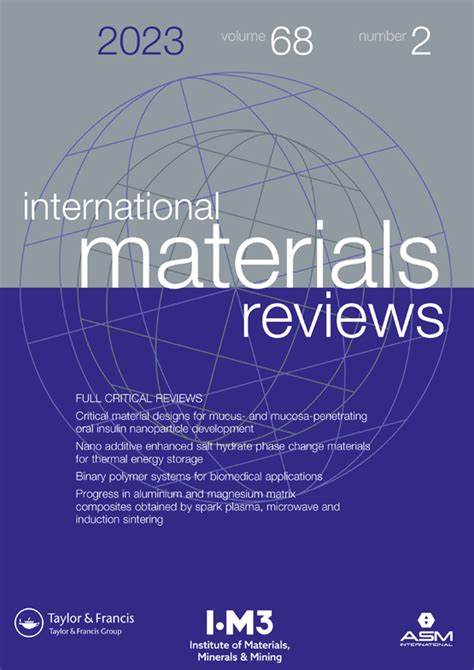Review on developments of bulk functionally graded composite materials
IF 15.5
1区 材料科学
Q1 MATERIALS SCIENCE, MULTIDISCIPLINARY
引用次数: 19
Abstract
ABSTRACT Monolithic components are often insufficient when a combination of conflicting properties, or a variation in properties at different regions within a material is required. Functionally graded composite materials (FGCM) are a relatively new class of materials with a systematic variation of the composition, microstructure, and properties along one direction. The graded structure offers tailorable property combinations not achievable with monolithic composites and significant recent research has been carried out on their development. An effort has been made in this article to review the latest developments on bulk FGCMs since 2015. The different processing techniques used for their fabrication have been discussed, highlighting their advantages, limitations, and recent advancements pertaining to FGCM fabrication. Various physical, mechanical, and thermal properties of FGCMs have been treated separately, and wherever possible, summary plots combining data from various research articles have been developed. Finally, potential areas for directing future FGCM research have been identified. Abbreviations: AM: Additive manufacturing; ANOVA: Analysis of variance; ATZ: Alumina toughened zirconia; BCP: Biphasic calcium phosphate; BEI or BSE: Backscattered electron images; BG: Bioactive glass; CAD: Computer aided design; CDHAp: Calcium-deficient hydroxyapatite; CNT: Carbon nanotube; CoCGO: Cobalt and gadolinium doped ceria; CTE: Coefficient of thermal expansion; DED: Direct energy deposition; DIC: Digital image correlation; ELDS: Electro discharge sintering; EDX: Energy dispersive x-ray analyser; FDM: Fused deposition modelling; FGCC: Functionally graded cemented carbides; FGCM: Functionally graded composite materials; FGHM: Functionally graded hard metals; FSP: Friction stir processing; FSW: Friction stir welding; GDI: Graded density impactor; HA: Hydroxyapatite; HIP: Hot isostatic pressing; LCM: Lithography based ceramic manufacturing; LDMD: Laser direct metal deposition; LMD: Laser metal deposition; LSCF: Lanthanum cobalt ferrite; MLG: Multilayered graphene; MMC: Metal matrix composites; MWCNT: Multi-walled carbon nanotubes; PAS: Plasma activated sintering; PFC: Plasma facing components; PM: Powder metallurgy; RHA: Rice husk ash; RVE: Representative volume element; SEM: Scanning electron microscope; SHAp: Stoichiometric hydroxyapatite; SLA: Stereolithography; SLM: Selective laser melting; SLS: Selective laser sintering; SOFC: Solid oxide fuel cells; SPS: Spark plasma sintering; TEM: Transmission electron microscope; UHTC: Ultra-high temperature ceramics; WAAM: Wire arc additive manufacturing; YSZ: Yttria stabilized zirconia块状功能梯度复合材料的研究进展
当需要组合相互冲突的特性,或材料内不同区域的特性变化时,单片组件往往是不够的。功能梯度复合材料(FGCM)是一类相对较新的材料,其组成、微观结构和性能沿一个方向有系统的变化。梯度结构提供了可定制的性能组合,这是单片复合材料无法实现的,最近对其发展进行了大量研究。本文回顾了2015年以来批量fgcm的最新进展。讨论了用于制造FGCM的不同加工技术,强调了它们的优点、局限性和有关FGCM制造的最新进展。fgcm的各种物理、机械和热性能已分别处理,并且在可能的情况下,已开发了综合各种研究文章数据的汇总图。最后,确定了指导未来FGCM研究的潜在领域。缩写:AM:增材制造;ANOVA:方差分析;ATZ:氧化铝增韧氧化锆;BCP:双相磷酸钙;BEI或BSE:背散射电子图像;BG:生物活性玻璃;CAD:计算机辅助设计;CDHAp:缺钙羟基磷灰石;CNT:碳纳米管;cogo:钴和钆掺杂的铈;CTE:热膨胀系数;DED:直接能量沉积;DIC:数字图像相关;ELDS:放电烧结;能量色散x射线分析仪;FDM:熔融沉积建模;FGCC:功能级配硬质合金;FGCM:功能梯度复合材料;FGHM:功能分级硬质金属;FSP:摩擦搅拌加工;FSW:搅拌摩擦焊;GDI:分级密度冲击器;HA:羟磷灰石;HIP:热等静压;LCM:基于光刻技术的陶瓷制造;激光直接金属沉积;LMD:激光金属沉积;LSCF:镧钴铁氧体;多层石墨烯;MMC:金属基复合材料;MWCNT:多壁碳纳米管;PAS:等离子体活化烧结;PFC:面向等离子体的组件;PM:粉末冶金;RHA:稻壳灰;RVE:代表性体积元;SEM:扫描电子显微镜;shape:化学计量羟基磷灰石;SLA:有限元;SLM:选择性激光熔化;SLS:选择性激光烧结;SOFC:固体氧化物燃料电池;SPS:火花等离子烧结;TEM:透射电子显微镜;UHTC:超高温陶瓷;WAAM:丝弧增材制造;钇稳定氧化锆
本文章由计算机程序翻译,如有差异,请以英文原文为准。
求助全文
约1分钟内获得全文
求助全文
来源期刊

International Materials Reviews
工程技术-材料科学:综合
CiteScore
28.50
自引率
0.00%
发文量
21
审稿时长
6 months
期刊介绍:
International Materials Reviews (IMR) is a comprehensive publication that provides in-depth coverage of the current state and advancements in various materials technologies. With contributions from internationally respected experts, IMR offers a thorough analysis of the subject matter. It undergoes rigorous evaluation by committees in the United States and United Kingdom for ensuring the highest quality of content.
Published by Sage on behalf of ASM International and the Institute of Materials, Minerals and Mining (UK), IMR is a valuable resource for professionals in the field. It is available online through Sage's platform, facilitating convenient access to its wealth of information.
Jointly produced by ASM International and the Institute of Materials, Minerals and Mining (UK), IMR focuses on technologies that impact industries dealing with metals, structural ceramics, composite materials, and electronic materials. Its coverage spans from practical applications to theoretical and practical aspects of material extraction, production, fabrication, properties, and behavior.
 求助内容:
求助内容: 应助结果提醒方式:
应助结果提醒方式:


